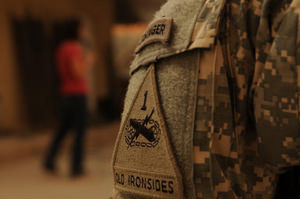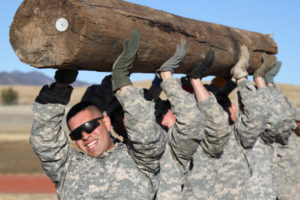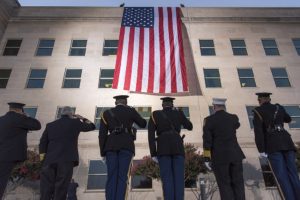Does Military Service Turn Young Men Into Sexual Predators?
It can be shown that the patterns of military sex crimes are old and widespread -- for generations, military service has transformed large numbers of American boys into sexual predators. So it seems reasonable to ask whether perhaps there is something about military culture or training or experience that can be identified as causative, and then, perhaps, changed.After generations of silence, the question deserves an answer, and not a simplistic one.
Penny Coleman, AlterNetThis article originally was published on AlterNet.
Every day, for four years as a West Point cadet, Tara Krause lived and worked alongside the men who had gang-raped her.
Still, she managed to graduate in 1982. She served as a field artillery officer during the Cold War and was attached to the 518th Military Intelligence Brigade during the Gulf War. In what she calls “an act of incredible self-destruction,” she married a three-tour Vietnam vet in 1985 and, for the next eight years, lived “the private hell of his PTSD.”
“Suicidal behavior, violence and degradation were common threads of daily life,” she told me. She survived only because when he put his gun to her head one day, it finally gave her the courage to flee. “Like Lot’s wife,” she says, she struggles not to look back.
It’s been almost 30 years since the rape, and Krause says she still “dance(s) the crushing daily struggle” of her own PTSD: “The nightmares, panic attacks, flashbacks, cold sweats, suicidal thoughts, zoning out, numbing all emotion and desperately avoiding triggers (reminders) — I have become a prisoner in my own home.”
Krause is rated 70 percent disabled by the [Department of Veterans Affairs] and has been in treatment at the Long Beach [Calif.] VA for the past six years.
For all the work she has done to heal her own injuries, she still has no answer for the question: “How do you get a group of Southern white teenagers, all of whom were Eagle Scouts, class presidents, scholars and athletes, to be capable of raping a classmate?”
The question deserves an answer, and not a simplistic one. A 2003 survey of female veterans from Vietnam through the Gulf War found that almost 8 in 10 had been sexually harassed during their military service, and 30 percent had been raped.
Yet for decades, in spite of the terrible numbers, the military has managed with astonishing success to get away with responding to grievances like Krause’s with silence, or denial, or by blaming “a few bad apples.” But when individual soldiers take the blame, the system gets off the hook.
And it can be shown that the patterns of military sex crimes are old and widespread — for generations, military service has transformed large numbers of American boys into sexual predators.
So it seems reasonable to ask whether perhaps there is something about military culture or training or experience that can be identified as causative, and then, perhaps, changed.
The correlation is difficult to dismiss. The majority of veterans behind bars today are there for a very specific type of crime: violence against women and children. That fact has held true since the first Bureau of Justice Statistics (BJS) surveys of veteran populations in the nation’s prisons in 1981, and there is evidence that those surveys only identified a much older problem.
The orgy of demonization, however, that both fueled and justified the disgraceful neglect of veterans in the aftermath of Vietnam makes this an especially fraught issue to take on.
But — without making any excuses for behaviors that cause irreparable harm to those who are victimized — there is little hope of change unless the tacit complicity of military institutions and culture is acknowledged. And that complicity most certainly did not begin recently.
World War II is remembered as a crucible and a coming-of-age ritual for the baby-faced boys it turned first into men and then into the “greatest generation.”
The butchery, the civilian atrocities, the summary executions, the appalling racism and the breakdown of hundreds of thousands of soldiers have been largely erased from communal memory. And so have the rapes perpetrated by American soldiers on our female enemies and allies alike.
In August and September 1944, when the fighting eased, French women were raped by their American liberators at three times the rate of civilian women in the U.S. And during the final drive through Germany in March and April 1945, more than 900 German women were raped by American soldiers, causing Gen. Dwight D. Eisenhower to issue a directive to Army commanders expressing his “grave concern” and instructing that speedy and appropriate punishments be administered.
According to Madeline Morris, the Duke University law professor and military historian who uncovered that lurid fragment of history, those numbers are almost certainly on the low side.
“Rape is particularly likely to have been undercounted because it is less serious than murder,” Morris explains, “it is reputedly the most underreported violent crime, even in the domestic context, and it was perpetrated in the ETO (European Theater of Operations) almost exclusively against non-Americans.”
Those women, especially German women, could not easily have found the courage — or the opportunity — to file complaints.
The memories of rape brought home by World War II soldiers surely changed their lives forever.
“What does rape do to the rapist?” is a question Krause has struggled with for 20 years. “Somewhere out there is that Rotarian, happy grandfather, son-done-good, solid citizen. Does he block it out, does he remember, does he feel a shred of guilt? Is it truly done with impunity?”
It is important to note that during World War II, according to Morris’ research, patterns of violent crime in the United States’ civilian population underwent sharp changes as well.
“While civilian murder and non-negligent manslaughter rates decreased 7.5 percent from prewar rates, aggravated assault rates increased substantially (19.9 percent), and forcible-rape rates increased dramatically (by more than 27 percent) above the prewar average.”
Similarly, since the wars in Iraq and Afghanistan began, BJS statistics show a 42 percent increase in reported domestic violence and a 25 percent increase in the reported incidence of rape and sexual assault.
Except for simple assault, which increased by 3 percent, the incidence of every other crime surveyed — including violent crimes overall — decreased, but once again, mirroring Morris’ World War II data, domestic violence, rape and sexual assault showed daunting increases.
The first BJS survey of incarcerated veterans found that two-thirds of those veterans had been convicted of rape or sexual assault. In military prisons as well, the report noted, “sexual assault was the most common offense for which inmates were held … accounting for nearly a full third of all military prisoners.”
That chilling aspect of soldiers’ criminal behavior held true in subsequent BJS surveys.
In 2000, veterans in state and federal prisons and local jails were twice as likely as non-veterans to be sentenced for a violent sexual crime. In the 2004 survey, 1 in 4 veterans in prison were sex offenders (1 in 3 in military prisons), compared to 1 in 10 incarcerated non-veterans.
Chris Mumola, author of the two most recent BJS reports, points out that “when sex crimes are excluded, the violent-offense incarceration rate of non-veterans is actually greater than the incarceration rate of veterans for all other offenses combined (651 per 100,000 versus 630 per 100,000).”
In fact, when sex crimes are excluded, adult male veterans are over 40 percent less likely to be in prison for a violent crime than their non-veteran counterparts. The same holds true for property crimes, drugs and public disorder — the rates are much higher rates for adult men without military experience.
“The one notable exception to this pattern,” Mumola says, “is sex assaults, including rape.”
The Veterans Health Administration has adopted the term “military sexual trauma” (MST) to refer to severe or threatening forms of sexual harassment and sexual assault sustained in military service.
Their records for 2007 show that 22.2 percent of female veterans and 1.3 percent of male vets (from all eras) who used the agency’s health services screened positive for MST. That represents a daunting increase of about 65 percent for both men and women over the agency’s 2003 data.
And the small percentage of men is somewhat misleading; the 2007 percentages translate into 45,564 women and 47,719 men whose injuries forced them to acknowledge their victimization and to seek help from the VA.
Some of that increase can perhaps be attributed to a 2005 congressional directive requiring the VA to improve its rate of screening returning soldiers for MST, but given that almost 90 percent of veterans don’t (or can’t) use VA health care services, it seems safe to assume that the actual numbers are considerably higher.
Those are just the numbers for veterans.
In 2008, the Pentagon received more than 2,900 sexual assault reports involving active-duty service members. That represents a 9 percent increase from 2007, a 26 percent increase in combat zones. Almost a third of those reports involved rape, and more than half involved aggravated sexual assault.
In a dazzling display of unapologetic spin, the increase was called “encouraging,” an indication of more reports rather than more assaults. It offered no evidence to back up that interpretation, save that the department “encourages greater reporting to hold offenders accountable for this crime.”
That seems an unlikely incentive given that only 10 percent of the 2008 complaints led to a court-martial (compared to a civilian rate of 40 percent). The rest received minor punishments, almost half were dismissed, and the report acknowledged that 90 percent of sexual assaults in the military aren’t reported at all.
Rape occurs almost twice as frequently in the military as it does among civilians, especially in wartime.
When a 2008 House Oversight and Government Reform subcommittee subpoenaed Kaye Whitley, director of the DoD’s Sexual Assault Prevention and Response Office (SAPRO), to explain what the department was doing to stop the escalating sexual violence in the military, her boss, Michael Dominguez, principal deputy undersecretary of defense for personnel and readiness, ordered her not to appear.
Only after the department was threatened with a contempt citation was Whitley made available to the committee. She then sought to reassure the members that DoD is conducting a “crusade against sexual assault,” and itemized all of the heroic measures the agency was planning to implement in the very near future — efforts that somehow, despite explicit directives and deadlines from Congress, the agency had not managed to launch at the time.
Tia Christopher, women veterans coordinator at Swords to Plowshares in San Francisco, holds Dominguez, not Whitley, responsible for flouting congressional directives.
“I heard him claim that the reason sexual assaults are so high in the military right now is the hip-hop influence. I don’t need to spell out why I found that so offensive. I fault Dominguez for not recognizing that it is a leadership issue.”
Christopher loves the military and calls it “a really beautiful machine” when it is working correctly. But she is a rape survivor, and she feels doubly betrayed by her superiors in the Navy. “They can respond to other situations, why not to sexual assault?”
Christopher was 18 when she joined the Navy, training to be a cryptologist. The night she was raped, she had been drinking.
“Underage drinking,” she notes, “is a big issue in the military. It gets you an Article 15, and it’s 100 percent guaranteed that you will be prosecuted for collateral misconduct. It is far more likely that you will get in trouble for collateral misconduct [from drinking alcohol] than for raping someone. So I destroyed all the evidence. I bleached my sheets and scrubbed myself up and didn’t come forward until two weeks later. I wanted to keep my military career, and I thought I could just get through it.
“But I saw him every day. I mustered with him. He would follow me into the chow hall and sit across from me while I ate. I stopped eating, couldn’t concentrate, started failing my courses. And I started having flashbacks, hallucinating. I thought I saw him everywhere.”
Christopher finally realized she needed help, but the female petty officer she first spoke to got her chief involved and, as the report went up the chain of command, her nightmare just got bigger.
“In my case, there were witnesses. They heard my head hit the wall in the barracks room, but they were drinking [underage], too.”
Her commanding officer promised them all immunity if they agreed to testify on her behalf, and then reneged on the deal.
“It ended up that they all got in trouble, and [her rapist] got off.” (In 2006, Christopher’s attacker was expelled from the military for another rape.)
“The last few months that I was in the service, I was assigned to X Division, mopping the stairs, cleaning the heads, picking hair out of the drains. It was my job to vacuum the different chief’s offices, and these sleazeballs would say things like, ‘Hey, Christopher, bend over when you’re sweeping.’ Or, ‘Hey Christopher, let me see them titties.’ When you come forward about a rape, basically you are just a slut.”
Christopher left the military in 2001, and it took her a long time to get her life back together. She still has panic attacks, flashbacks, trouble sleeping. But, with help from a women’s psychotherapy group at the Seattle VA, and the rich support from sympathetic colleagues at Swords to Plowshares, she has developed a lot of coping skills.
After seven years, and some good therapy, she feels strong enough to manage her advocacy and policy work.
“I’ve testified before the California state legislature, and I was invited to testify before Congress. I speak out about MST as much as I do so other women don’t have to. This is not just my job. There is no way I would ever give my clients to the media. I remember what it was like, being fresh out of the service and going through that trauma.”
Lisa Pellerin, who has facilitated sex-offender programs for the New York State Department of Corrections for six years, believes that “everyone has the potential to be a sex offender. It depends on how they have been conditioned. When they are in the military, supporting the brotherhood is the most important thing. Soldiers do what they feel they have to do because they don’t want to be seen as weak or unable to perform.
“Sexual abuse has always been about power and control. If you are exposed and desensitized to certain sexual behaviors, they become normalized.”
One of the most basic conditioning strategies military training uses to destabilize a recruit’s inherent disinclination to kill is the inculcation of a dehumanized enemy. Soldiers are taught that “we” are the good guys; “they” are the “others.” “They” are easier to kill because they are not us. They are also easier to despise. “Others” — the nips, the gooks, the hajis — come and go, but ever reliable and constant is “the girl.”
Even in this new 20 percent female military, misogynist marching rhymes (aka jodies) are still used, and drill instructors still shame recruits with taunts of pussy or sissy, faggot or girl. Patty McCann, who signed up with the Illinois National Guard when she was 17 and deployed to Iraq when she was 20, still feels betrayed when she remembers her drill sergeant yelling, “Does your pussy hurt?” and “Do you need a tampon?”
A culture that encourages violence and misogyny, says Helen Benedict, attracts a disproportionate number of sexually violent men: half of male recruits enlist to escape abusive families, a history that is often predictive of an abuser.
But whatever attracts them, and wherever they come from, this is about a system plagued by rot, and not about a few bad apples. American veterans embody the inevitable, predictable blowback from that rotten system.
It is both unjust and disingenuous to focus on what our soldiers have become without talking about what we have become: A society that romanticizes its warriors, demonizes its veterans and devalues its women.
“Did I serve my full enlistment?” Christopher says. “No. But that’s because some shitbag sailor who shouldn’t have been wearing the uniform came into my life. Why is that my issue?
“This is a leadership issue.”
Your support is crucial…With an uncertain future and a new administration casting doubt on press freedoms, the danger is clear: The truth is at risk.
Now is the time to give. Your tax-deductible support allows us to dig deeper, delivering fearless investigative reporting and analysis that exposes what’s really happening — without compromise.
Stand with our courageous journalists. Donate today to protect a free press, uphold democracy and unearth untold stories.








You need to be a supporter to comment.
There are currently no responses to this article.
Be the first to respond.